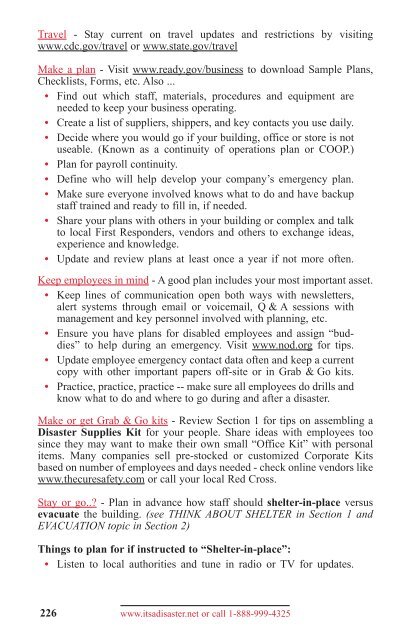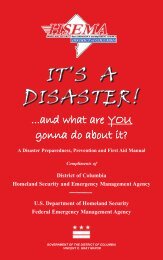disaster 5th 1108_5th ed 2011 - Homeland Security and Emergency ...
disaster 5th 1108_5th ed 2011 - Homeland Security and Emergency ...
disaster 5th 1108_5th ed 2011 - Homeland Security and Emergency ...
Create successful ePaper yourself
Turn your PDF publications into a flip-book with our unique Google optimized e-Paper software.
Travel - Stay current on travel updates <strong>and</strong> restrictions by visiting<br />
www.cdc.gov/travel or www.state.gov/travel<br />
Make a plan - Visit www.ready.gov/business to download Sample Plans,<br />
Checklists, Forms, etc. Also ...<br />
• Find out which staff, materials, proc<strong>ed</strong>ures <strong>and</strong> equipment are<br />
ne<strong>ed</strong><strong>ed</strong> to keep your business operating.<br />
• Create a list of suppliers, shippers, <strong>and</strong> key contacts you use daily.<br />
• Decide where you would go if your building, office or store is not<br />
useable. (Known as a continuity of operations plan or COOP.)<br />
• Plan for payroll continuity.<br />
• Define who will help develop your company’s emergency plan.<br />
• Make sure everyone involv<strong>ed</strong> knows what to do <strong>and</strong> have backup<br />
staff train<strong>ed</strong> <strong>and</strong> ready to fill in, if ne<strong>ed</strong><strong>ed</strong>.<br />
• Share your plans with others in your building or complex <strong>and</strong> talk<br />
to local First Responders, vendors <strong>and</strong> others to exchange ideas,<br />
experience <strong>and</strong> knowl<strong>ed</strong>ge.<br />
• Update <strong>and</strong> review plans at least once a year if not more often.<br />
Keep employees in mind - A good plan includes your most important asset.<br />
• Keep lines of communication open both ways with newsletters,<br />
alert systems through email or voicemail, Q & A sessions with<br />
management <strong>and</strong> key personnel involv<strong>ed</strong> with planning, etc.<br />
• Ensure you have plans for disabl<strong>ed</strong> employees <strong>and</strong> assign “buddies”<br />
to help during an emergency. Visit www.nod.org for tips.<br />
• Update employee emergency contact data often <strong>and</strong> keep a current<br />
copy with other important papers off-site or in Grab & Go kits.<br />
• Practice, practice, practice -- make sure all employees do drills <strong>and</strong><br />
know what to do <strong>and</strong> where to go during <strong>and</strong> after a <strong>disaster</strong>.<br />
Make or get Grab & Go kits - Review Section 1 for tips on assembling a<br />
Disaster Supplies Kit for your people. Share ideas with employees too<br />
since they may want to make their own small “Office Kit” with personal<br />
items. Many companies sell pre-stock<strong>ed</strong> or customiz<strong>ed</strong> Corporate Kits<br />
bas<strong>ed</strong> on number of employees <strong>and</strong> days ne<strong>ed</strong><strong>ed</strong> - check online vendors like<br />
www.thecuresafety.com or call your local R<strong>ed</strong> Cross.<br />
Stay or go.. - Plan in advance how staff should shelter-in-place versus<br />
evacuate the building. (see THINK ABOUT SHELTER in Section 1 <strong>and</strong><br />
EVACUATION topic in Section 2)<br />
Things to plan for if instruct<strong>ed</strong> to “Shelter-in-place”:<br />
• Listen to local authorities <strong>and</strong> tune in radio or TV for updates.<br />
226 www.itsa<strong>disaster</strong>.net or call 1-888-999-4325





